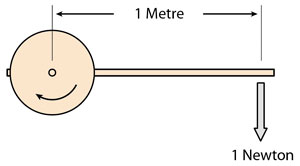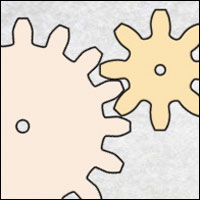Rotary motion is motion in a circle. As a mechanism rotates it turns about a fixed point. The speed of rotation is measured in revolutions per minute or rpm. This the number of complete rotations made in one minute.
No iFrame ‘;
print ‘Using HTML 5 ‘;
}
else{
print’
‘;
print ‘Using Flash‘;
}
?>
 It is the starting point for many mechanisms. Measurement: Rotary motion is measured in either angular velocity, the number of degrees turned in a given time, or in revolutions per minute (rpm). The direction of turn, either clockwise or anti-clockwise is also part of the measurement of rotary motion. The strength of rotary motion is known as the torque, the turning force. Torque is measured in Newton Metres defined as the force of one newton acting at a perpendicular distance of one metre from the axis of rotation.
It is the starting point for many mechanisms. Measurement: Rotary motion is measured in either angular velocity, the number of degrees turned in a given time, or in revolutions per minute (rpm). The direction of turn, either clockwise or anti-clockwise is also part of the measurement of rotary motion. The strength of rotary motion is known as the torque, the turning force. Torque is measured in Newton Metres defined as the force of one newton acting at a perpendicular distance of one metre from the axis of rotation.
Examples of mechanisms using rotary motion are wheels, helicopter blades, gears, volume knobs, steering wheel, washing machine drum and the London Eye
ConversionsRotary motion to: |
Transformations |
|||
|---|---|---|---|---|
| Linear Motion | Wheels. Rack and pinion. |
Increase / Decrease | Gears. Chain. Worm gear. |
|
| Reciprocating Motion | Piston. Geared mechanism. Cardan gear. |
Reflect | Gears. | |
| Oscillation | Crank. Quick return. |
Rotate | Bevel gear. | |
| Intermittent Motion | Geneva Drive. | |||
| Irregular Motion | Cam. |


